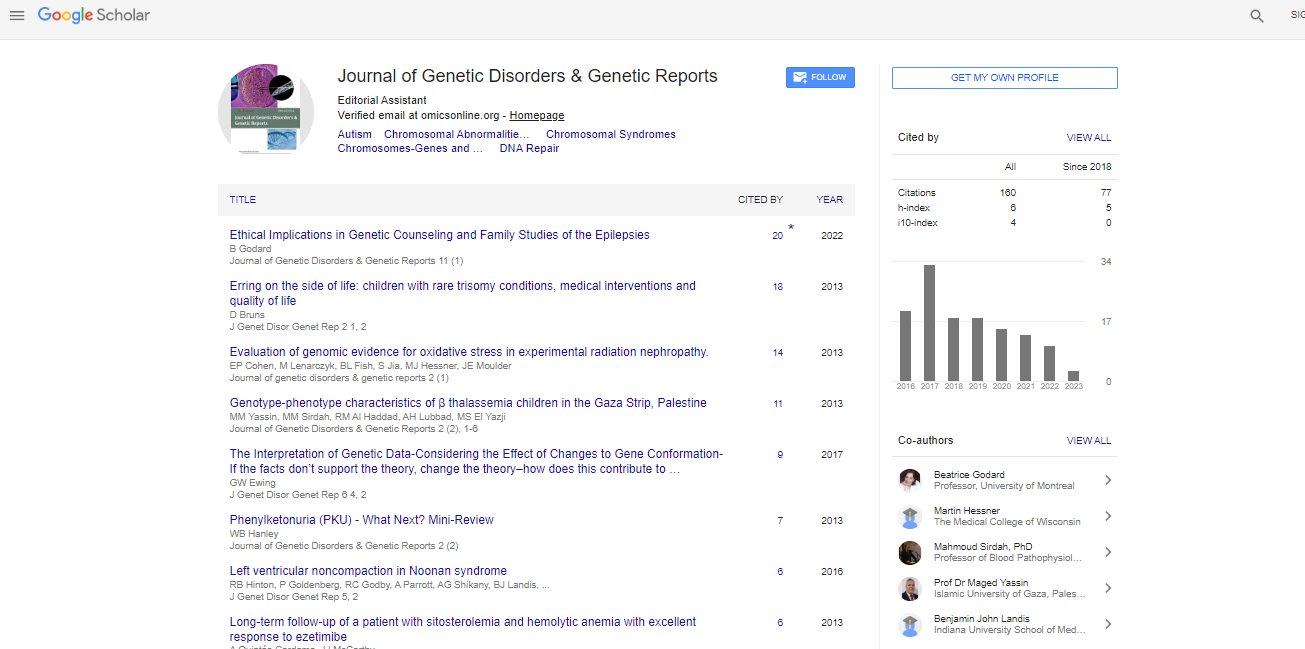Short Communication, J Genet Disor Genet Rep Vol: 12 Issue: 3
X Chromosomes Linked Traits: Unveiling the Genetics Chromosome
Hualan Zen*
1Department of Human Genetics, University of Debrecen, Debrecen, Hungary
*Corresponding Author: Hualan Zen,
Department of Human Genetics, University
of Debrecen, Debrecen, Hungary
E-mail: zenhualan@gmail.com
Received date: 15 May, 2023, Manuscript No JGDGR-23-106037;
Editor assigned date: 17 May, 2023, PreQC No JGDGR-23-106037 (PQ);
Reviewed date: 01 June, 2023, QC No JGDGR-23-106037;
Revised date: 08 June, 2023, Manuscript No JGDGR-23-106037 (R);
Published date: 16 June, 2023, DOI: 10.4172/2576-1439.1000213
Citation: Zen H (2023) X Chromosomes Linked Traits: Unveiling the Genetics Chromosome. J Genet Disor Genet Rep 12:3.
Abstract
Description
X-linked traits are fascinating genetic characteristics that are influenced by genes located on the X chromosome. As one of the two sex chromosomes, the X chromosome plays a crucial role in determining various traits and disorders in both males and females. Understanding X-linked traits and their inheritance patterns is essential for comprehending the complexities of genetic diversity and the occurrence of certain genetic conditions [1]. The intriguing gene of X-linked traits, shedding light on their mechanisms, inheritance patterns, and implications for human health.
X Chromosomes inheritance
The X chromosome is one of the two sex chromosomes, with the Y chromosome being the other in males. Females possess two X chromosomes (XX), while males have one X and one Y chromosome (XY) [2]. As a result, males inherit their X chromosome from their mother and the Y chromosome from their father, while females inherit one X chromosome from each parent. This difference in inheritance patterns plays a significant role in the expression of X-linked traits [3].
X-linked recessive traits
X-linked recessive traits are characterized by their expression predominantly in males. This is because males only have one copy of the X chromosome, so if they inherit a recessive allele for an X-linked trait, they will express the trait [4]. In contrast, females need to inherit two copies of the recessive allele (one from each parent) to express the trait fully. Examples of X-linked recessive traits include red-green color blindness, hemophilia, and Duchenne muscular dystrophy [5]. Carrier females may exhibit milder symptoms or be unaffected.
X-linked dominant traits
X-linked dominant traits are characterized by their expression in both males and females, but their inheritance patterns differ between the sexes. In males, a single copy of the X-linked dominant allele is sufficient for expression since they only have one X chromosome [6]. In females, the presence of two X chromosomes allows for a more complex inheritance pattern. In some cases, females may exhibit more severe symptoms due to skewed X-chromosome inactivation.
Examples of X-linked dominant traits include Rett syndrome and fragile X syndrome [7].
Genetic counseling and x-linked traits
The understanding of X-linked traits is crucial for genetic counseling and family planning. Genetic testing can identify individuals who carry X-linked genetic variants, providing information about the risk of passing the trait to their offspring [8]. Carrier testing is particularly important for X-linked recessive disorders, as carrier females may have a 50% chance of transmitting the trait to their children. Genetic counseling empowers individuals and families to make informed decisions regarding family planning, reproductive options, and potential medical management.
X- Chromosome inactivation process
In females, X-chromosome inactivation is a process that balances gene expression between the two X chromosomes. One of the X chromosomes is randomly inactivated in each cell, ensuring that females have an equal dosage of X-linked genes to males [9]. However, certain genes on the inactivated X chromosome may escape this inactivation process, resulting in their expression from both X chromosomes. X-chromosome escape can lead to variations in phenotypic expression and contribute to the complexity of X-linked traits.
Advancements and future directions
Advancements in genetic testing, sequencing technologies, and our understanding of X-linked traits continue to expand our knowledge in this field. Improved diagnostic techniques, such as next-generation sequencing, enable more accurate and comprehensive analysis of Xlinked disorders [10]. Furthermore, ongoing research and collaborative efforts are unraveling the underlying mechanisms of X-linked traits, providing insights into gene regulation, X-inactivation, and potential therapeutic interventions.
Conclusion
X-linked traits present an intriguing realm within the field of genetics. Understanding the influence of the X chromosome on various traits and disorders is crucial for comprehending genetic diversity, inheritance patterns, and disease prevalence. By unraveling the mechanisms and inheritance patterns of X-linked traits, scientists and clinicians gain insights into human health, genetic counseling, and potential therapeutic interventions. Continued research and advancements in the field of X-linked traits will further our understanding of these intriguing genetic characteristics and their implications for human well-being.
References
- Teitz LS, Pyntikova T, Skaletsky H , Page DC (2018) Selection has countered high mutability to preserve the ancestral copy number of y chromosome amplicons in diverse human lineages. Am J Hum Genet 103: 261–275.
[Crossref] [Google scholar] [Pubmed]
- Bachtrog D (2013) Y-chromosome evolution: emerging insights into processes of Y-chromosome degeneration. Nat Rev Genet 14:113–124.
[Crossref] [Google scholar] [Pubmed]
- Krausz C, Casamonti E (2017) Spermatogenic failure and the Y chromosome. Hum Genet 136:637–655.
[Crossref] [Google scholar] [Pubmed]
- Rozen S, Skaletsky H, Marszalek J, Minx P (2003) Abundant gene conversion between arms of palindromes in human and ape Y chromosomes. Nature 423:873–876.
[Crossref] [Google scholar] [Pubmed]
- Skaletsky H, Janet D, Patrick J, Holland S, Robert H et al. (2003) The male-specific region of the human Y chromosome is a mosaic of discrete sequence classes. Nature 423: 825–837.
[Crossref] [Google scholar] [Pubmed]
- Kuroda K, Helen S, Laura G, Patrick J, Holland S et al. (2001) The AZFc region of the Y chromosome features massive palindromes and uniform recurrent deletions in infertile men. Nat Genet 29: 279–286.
[Crossref] [Google scholar] [Pubmed]
- Skov L, Mikkel H (2017) Analysis of 62 hybrid assembled human Y chromosomes exposes rapid structural changes and high rates of gene conversion. PLOS Genet 13(8):2-20.
[Crossref] [Google scholar] [Pubmed]
- Hallast P, Balaresque P, Bowden G, Ballereau S, Mark A (2013) Recombination dynamics of a human y-chromosomal palindrome: rapid gc-biased gene conversion, multi-kilobase conversion tracts, and rare inversions. PLoS Genet 9(7): e1003666.
[Crossref] [Google scholar] [Pubmed]
- Lucotte EA, Laurits S, Jacob M, Moisès C, Kasper M et al. (2018) Dynamic copy number evolution of x- and y-linked ampliconic genes in human populations. Genetics 209: 907–920.
[Crossref] [Google scholar] [Pubmed]
- Ye D, Arslan A Zaidi, Marta Tomaszkiewicz, Kate Anthony, Corey Liebowitz et al.(2018) High levels of copy number variation of ampliconic genes across major human Y haplogroups. Genome Biol Evol 10:1333–1350.
[Crossref] [Google scholar] [Pubmed]
 Spanish
Spanish  Chinese
Chinese  Russian
Russian  German
German  French
French  Japanese
Japanese  Portuguese
Portuguese  Hindi
Hindi 



